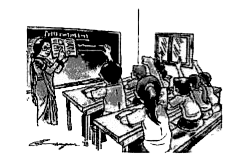Using integration, find the area of the region bounded by :
(i)(1,0),(4,5)and(6,3)
(ii) (1,0),(2,2)and(3,1)
(iii)(−1,2),(1,5)and(3,4)
(iv) (2,3),(3,5)and(3,4)
(v) (−1,0),(1,3)and(3,2)
(vi) (1,3),(2,5)and(3,4)
(vii) (4,1),(6,6)and(8,4)
(viii) (2,5),(4,7)and(6,2)
(ix) (−2,1),(0,4)and(2,3)
(x) (2,1),(3,4)and(5,2).
The correct Answer is:(i)7(ii)32(iii)4(iv)32(v)4(vi)32(vii)7(viii)7(ix)4(x)4 (sq. units).
Topper's Solved these Questions
- BOOK - MODERN PUBLICATIONCHAPTER - APPLICATIONS OF THE INTEGRALS EXERCISE - OBJECTIVE TYPE QUESTIONS20videos
APPLICATIONS OF THE INTEGRALS
- BOOK - MODERN PUBLICATIONCHAPTER - APPLICATIONS OF THE INTEGRALS EXERCISE - OBJECTIVE TYPE QUESTIONS -FILL IN THE BLANKS5videos
APPLICATIONS OF THE INTEGRALS
- BOOK - MODERN PUBLICATIONCHAPTER - APPLICATIONS OF THE INTEGRALS EXERCISE - EXERCISE 8 (A)28videos
APPLICATIONS OF THE INTEGRALS
- BOOK - MODERN PUBLICATIONCHAPTER - APPLICATIONS OF DERIVATIVESEXERCISE - CHAPTER TEST (1)12videos
APPLICATIONS OF DERIVATIVES
- BOOK - MODERN PUBLICATIONCHAPTER - CONTINUITY AND DIFFERENTIABILITYEXERCISE - CHAPTER TEST12videos
CONTINUITY AND DIFFERENTIABILITY
Similar Questions
In which octant the following points lie :
(i) (2, 1, 4) (ii) (-1,2,4)
(iii) (1,-3, 2) (iv) (1, 5,-6)
(v) (2, -1, -3) (vi) (-2, 3, -5)
(vii) (-4, -1, 3) (viii) (-1, -2, 3)View SolutionIn which octant the following points lie :
(i) (2, 1, 4) (ii) (-1,2,4)
(iii) (1,-3, 2) (iv) (1, 5,-6)
(v) (2, -1, -3) (vi) (-2, 3, -5)
(vii) (-4, -1, 3) (viii) (-1, -2, 3)View Solution
Knowledge Check
- Question 1 - Select One
There are three relations R1,R2 and R3 such that
R1={(2,1),(3,1),(4,2)},
R2 = {(2,2),(2,4),(3,3),(4,4)} and
R3 = {(1,2),(2,3),(3,4),(4,5),(5,6),(6,7)}
thenAR1andR2 are functionsBR2andR3 are functionsCR1andR3 are functionsDOnly R1 is a function
Use the number line and add the following integers :
(i)9+(−6) (ii)(−3)+7 (iii)8+(−8)
(iv) (−1)+(−3) (v)(−4)+(−7) (vi)(−2)+(−8)
(vii)3+(−2)+(−4) (viii)(−1)+(−2)+(−3) (ix)5+(−2)+(−6)View SolutionFor teaching the concept of probability, Mrs. Verma decided to use two dice. Shet took a pair of die and write all the possible outcomes on the blackboard. All possible outcomes wave:

(1,1), (1,2), (1,3), (1,4), (1,5), (1,6)
(2,1), (2,2), (2,3), (2,4), (2,5), (2,6)
(3,1), (3,2), (3,3), (3,4), (3,5), (3,6)
(4,1), (4,2), (4,3), (4,4), (4,5), (4,6)
(5,1), (5,2), (5,3), (5,4), (5,5), (5,6)
(6,1), (6,2), (6,3), (6,4), (6,5), (6,6)
The probability that 4 will not come up on either of them isView SolutionFor teaching the concept of probability, Mrs. Verma decided to use two dice. Shet took a pair of die and write all the possible outcomes on the blackboard. All possible outcomes wave:

(1,1), (1,2), (1,3), (1,4), (1,5), (1,6)
(2,1), (2,2), (2,3), (2,4), (2,5), (2,6)
(3,1), (3,2), (3,3), (3,4), (3,5), (3,6)
(4,1), (4,2), (4,3), (4,4), (4,5), (4,6)
(5,1), (5,2), (5,3), (5,4), (5,5), (5,6)
(6,1), (6,2), (6,3), (6,4), (6,5), (6,6)
The probability that 5 will come up at least once is:View SolutionFor teaching the concept of probability, Mrs. Verma decided to use two dice. Shet took a pair of die and write all the possible outcomes on the blackboard. All possible outcomes wave:

(1,1), (1,2), (1,3), (1,4), (1,5), (1,6)
(2,1), (2,2), (2,3), (2,4), (2,5), (2,6)
(3,1), (3,2), (3,3), (3,4), (3,5), (3,6)
(4,1), (4,2), (4,3), (4,4), (4,5), (4,6)
(5,1), (5,2), (5,3), (5,4), (5,5), (5,6)
(6,1), (6,2), (6,3), (6,4), (6,5), (6,6)
The probability that 6 will come up on both dice isView SolutionFor teaching the concept of probability, Mrs. Verma decided to use two dice. Shet took a pair of die and write all the possible outcomes on the blackboard. All possible outcomes wave:

(1,1), (1,2), (1,3), (1,4), (1,5), (1,6)
(2,1), (2,2), (2,3), (2,4), (2,5), (2,6)
(3,1), (3,2), (3,3), (3,4), (3,5), (3,6)
(4,1), (4,2), (4,3), (4,4), (4,5), (4,6)
(5,1), (5,2), (5,3), (5,4), (5,5), (5,6)
(6,1), (6,2), (6,3), (6,4), (6,5), (6,6)
The probability that both numbers comes up are even, isView SolutionFor teaching the concept of probability, Mrs. Verma decided to use two dice. Shet took a pair of die and write all the possible outcomes on the blackboard. All possible outcomes wave:

(1,1), (1,2), (1,3), (1,4), (1,5), (1,6)
(2,1), (2,2), (2,3), (2,4), (2,5), (2,6)
(3,1), (3,2), (3,3), (3,4), (3,5), (3,6)
(4,1), (4,2), (4,3), (4,4), (4,5), (4,6)
(5,1), (5,2), (5,3), (5,4), (5,5), (5,6)
(6,1), (6,2), (6,3), (6,4), (6,5), (6,6)
The probabiliyt that both numbers comes up are prime numbers, isView SolutionWhich of the following relations are functions? Give reasons. If it is a function, determine its domain and range:
(i) {(2,1), (3,1),(4,2)}
(ii) {(2,2),(2,4),(3,3),(4,4)}
(iii) {(2,1),(5,1),(8,1),(11,2),(14,2),(17,2)}
(iv) {(1,2),(2,3),(3,4),(4,5),(5,6),(6,7)}
(v){(2,1),(4,2),(6,3),(8,4),(10,5)}
(vi) {(1,2),(2,3),(3,4),(3,5),(3,7),(4,8)}View Solution

